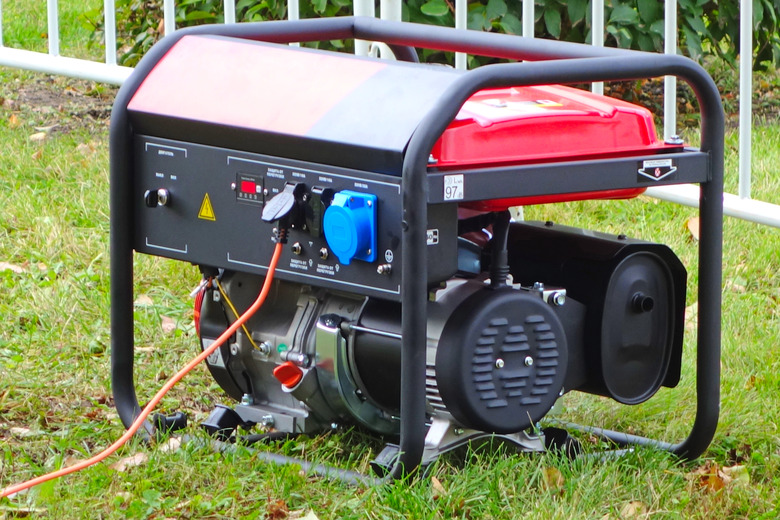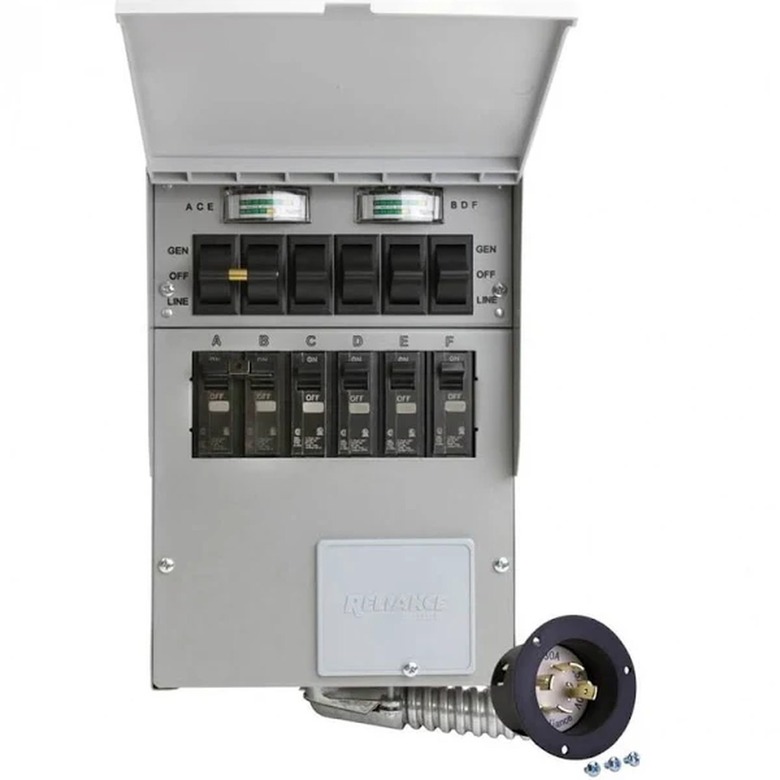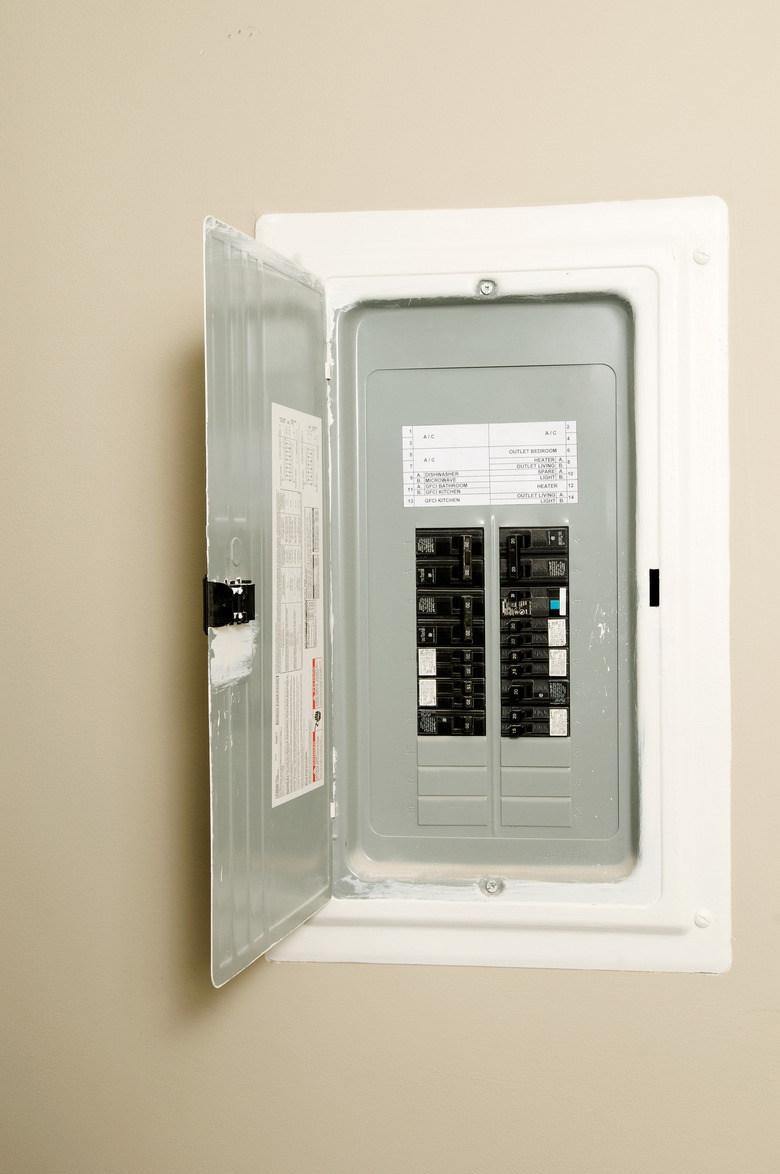A Guide To Manual Transfer Switches — The Safest Way To Use A Portable Generator
We may receive a commission on purchases made from links.
The safest and most convenient way to use a backup generator during a power outage is to connect it directly to your home's electrical service panel, and if you do that, you must wire it through an automatic or manual transfer switch. This is a requirement of the National Electrical Code (NEC), and the purpose is to protect utility line workers who are trying to restore power. The switch disconnects the panel from the utility service while the generator is running to prevent backfeeding and energizing the line.
Many standby generators, such as the Generac whole-house 22,000 watt, 200 amp model, come equipped with their own automatic transfer switches. This functionality isn't available with portable generators, however, so you have to purchase and connect your own — and because the procedure involves working in the panel, you should enlist the help of an electrician. A properly installed and wired generator transfer switch makes it impossible for the generator to energize some of the household circuits directly from the service panel, so you don't have to use extension cords running from the generator.
A manual transfer switch has a lot going for it beyond fulfilling NEC requirements. It's convenient and safe, saving you the trouble of fumbling around with extension cords in the middle of a blackout. Because the switch allows connection to the main panel, the generator can power hardwired appliances that cannot be powered by extension cords, such as a furnace or well pump, and you can also use the light switches if desired.
What's a Manual Transfer Switch?
What's a Manual Transfer Switch?
When it's mounted on a wall, a manual transfer switch looks like a small circuit breaker panel. Under the cover are up to 10 toggle switches, each controlling a single circuit, or there may be just one toggle if the generator is big enough to power the whole house. The switches look like breaker switches, but they don't trip; you have to manually turn them on and off. This is important to remember because when power is restored and you turn off the generator, you'll still be in blackout conditions until you flip the transfer switch back to utility line power.
The switches are in a rectangular metal enclosure that has a single neutral and ground wire for connection to the panel. Each switch has two hot wires, one red and one black, for connection to individual breakers. When connecting a switch to a breaker, you remove the existing black wire from the breaker and splice it to the black wire on the switch. Then, you connect the red wire to the breaker. This forces electricity coming into the panel from the line to pass through the switch before reaching the breaker.
The transfer switch also has an input cable that terminates in a plug that can be plugged into the receptacle on a generator. The cable is wired to pass through an internal circuit breaker that protects the switch from overheating before it passes through the switch itself. The switch has only two positions: line and generator. When you select one, the other is automatically disconnected.
Why Install a Manual Transfer Switch?
Why Install a Manual Transfer Switch?
You don't absolutely need a transfer switch to use a portable generator; instead, you can use extension cords to power the appliances you really need and tough it out in semidarkness until the power comes back on. Most power outages last less than 24 hours, so you usually don't have to wait too long for that to happen. However, you do have to keep a door or window partially open for the cords to pass through, which isn't ideal in the middle of a storm with heavy wind and rain or in freezing cold. When you install a transfer switch, you only need a single extension cord, and you plug it into a permanently installed power inlet box, so you don't need to keep doors and windows open.
The main reason for installing a transfer switch is to allow you to energize the panel rather than individual appliances. Some of the amenities you need the most are hardwired, such as the water pump and pressure pump as well as the light switches, air conditioning unit and electric stove — and the panel has to be energized before you can use them. Moreover, energizing the panel and leaving all your corded appliances plugged into the wall is safer and easier than plugging them all into extension cords. The cords snake through the house and create tripping hazards at a time when you can't see very well because the lights are off.
You could choose to install an automatic transfer switch, which will monitor your electrical system and switch on the generator automatically when an outage occurs provided the generator has an automatic start function. As an alternative, you could also install a combination load center and transfer switch, such as the Generac GenReady, which integrates a transfer switch into a 200-amp service panel with a NEMA 1 configuration for indoor applications or a NEMA 3R configuration for outdoor applications.
That may be a better option than a manual switch if you experience frequent outages or you have sensitive equipment in the house that depends on steady power. A manual transfer switch, though, is smaller, less expensive and easier to install and maintain than an automatic switch or a combination load center and is ideally suited for manual-start generators.
Sizing a Manual Transfer Switch
Sizing a Manual Transfer Switch
The size of a transfer switch isn't a measure of its physical dimensions but of the maximum current (in amps) it's designed to handle. Switches are available in sizes from 30 amps all the way to 3,000 amps, and while using a switch that's too large won't cause any problems, it's a waste of money. One way to determine the size of switch you need is to add up the current draw of the total number of appliances you intend to use at one time. You may have already done this when determining the wattage of the generator. If you haven't, you may find it complicated to do yourself, and input from an electrician might be helpful.
There's an easier way: Just look at the current rating of the highest-rated receptacle on the generator. The total current draw cannot exceed that without overloading the generator. In addition to 120-volt receptacles, most portable generators that homeowners would use for emergency backup power have at least one twist-lock 240-volt receptacle, and some have two.
The Westinghouse WGen9500DF, for example, has one outlet rated for 30 amps and one rated for 50 amps. If you were to use that generator for whole-house emergency backup, you would plug into the 50-amp receptacle, so your transfer switch would have to be rated for 50 amps (or 60 amps if you can't find a 50-amp switch). You could opt to use the 30-amp receptacle to power only selected circuits, but in that case, you could still use the 50-amp transfer switch. If you purchase a 30-amp switch instead, you'll be able to use it with the 30-amp receptacle but not the 50-amp one.
Installation of a Transfer Switch
Installation of a Transfer Switch
Ideally, the transfer switch is mounted on the wall as close to the main service panel as possible to eliminate the need for extra cable. That's especially important if you're wiring the switch to individual breakers because each breaker needs two hot wires from the switch, and if you connect to 10 breakers, you're working with 20 wires. The switch has its own cord to receive power from the generator, but the cords supplied are seldom very long, so you might need to replace yours with a longer one or use an extension cord of the proper gauge (10 or 8 gauge depending on the amperage).
You have to run the power cable to the generator, and since it has to be outside (you should never operate a generator indoors), you'll probably need an extension cord. The proper way to use an extension cord with a transfer switch is to run the switch cord to an exterior wall, connect it to a power inlet box with the same plug configuration as the generator and plug the generator into the box receptacle, which is mounted on the outside wall. The cord can be rolled up and stored outdoors or left plugged into the generator depending on whether or not it has a permanent location. Generators make noise, so you'll want yours as far from the house as possible, which means the longer the cord you use, the better.
Connecting the switch to the panel is a job for an electrician or a homeowner with enough electrical experience to feel comfortable working in the service panel. The panel has to be de-energized and the switch wires either connected to the main breaker on the panel (for a whole-house application) or to selected individual breakers. The latter installation calls for a box with multiple switches, with each switch wired to an individual breaker. Circuits that operate at 240 volts have double-pole breakers, and since each switch has only one set of wires, it takes two switches to control a 240-volt breaker.
How to Use a Manual Transfer Switch
How to Use a Manual Transfer Switch
When a power outage occurs, you'll want to go outside, start the generator and plug it into the power inlet box. The generator is now sending power to the switch, which has a sensing breaker that prevents backfeeding to the grid. Once the generator is up and running, flip the transfer to power household circuits. The lights will come on as well as the refrigerator, the air conditioner and anything else connected to the generator for as long as it runs. When lights and appliances that aren't connected to the generator come on, indicating that power has been restored, flip the transfer switch back to grid power and then shut off the generator.
If you have a gas or diesel generator, it's a good idea to run it periodically for a few minutes to circulate fuel through the carburetor and to keep it clean, prevent internal parts from seizing up and generally keep the generator in good working order. Be sure to unplug the power cord before you start it to prevent backfeed into the power lines. Most homeowners will have done that already as well as rolled up and stowed the power cord and moved the generator to a safe storage spot. Remember to always move the generator outdoors before starting it, even for maintenance, because the engine emits carbon monoxide when it's running.
References
- YouTube: Ask This Old House – How to Install a Manual Transfer Switch for a Portable Generator
- Electric Generators Direct: Manual Transfer Switch Buyer's Guide
- Generator Grid: Transfer Switch for Your Portable Generator: Buyer's Guide
- Mr. Electric: Automatic vs. Manual Transfer Switches
- PSI Control Solutions: How to Choose the Right Manual Transfer Switch
- Electric Generators Direct: GenReady Load Center and Transfer Switch
- AC Connectors: How to Use a Manual Transfer Switch System for Your Home


